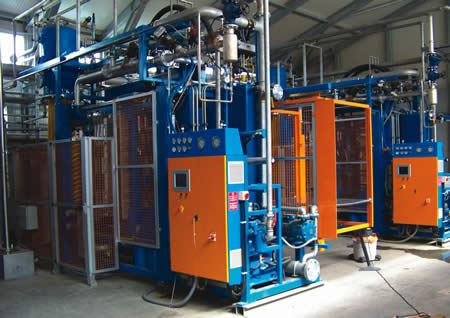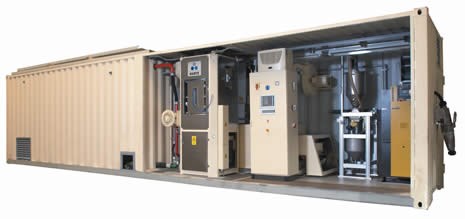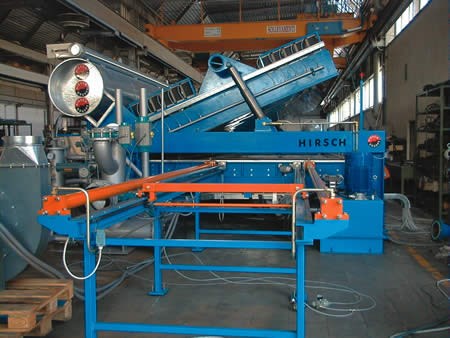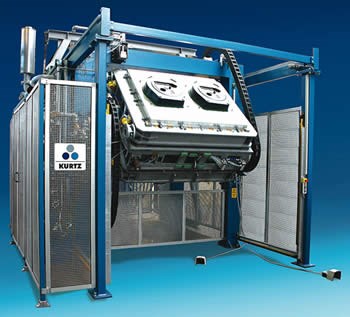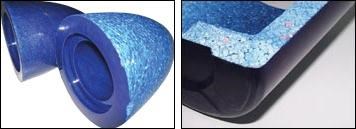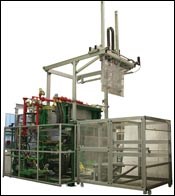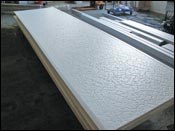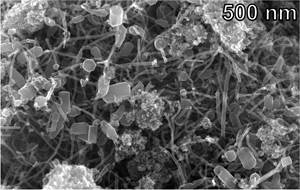Several 'Firsts' in Expandable Bead Molding
EPS molding machine builders have been busy in R&D. The driver is strong growth in EPS shape molding, especially large parts like fish boxes and insulated concrete forms (ICFs) for construction.
Three machine builders at the K Show in Germany last October displayed new transportable “kit” factories for EPS shape molding. Hirsch of Austria, Promass of Italy, and Kurtz of Germany developed molding-plants-in-a-box that can make ICF blocks at a construction site or for rapid reconstruction after natural disasters.
Mane Electricals of India addressed the market for rapid construction of shelters with a giant shape-molding machine capable of making single panels for cast concrete walls, floor, and ceiling of a 10 x 10 ft shelter that can be built in 4 hr.
Kurtz also showed new rotating tools for EPS and EPP designed for faster cycles and more complex parts. And Alessiotech of Italy showed the first dual-sided “glazing” or “crystallizing” of EPS shapes. Glazing one surface of EPS and EPP is a European technology that emerged about 10 years ago for ceiling and roof tiles and is virtually unknown here.
SHAPE MOLDING TO GO
Two of the new transportable shape-molding plants are free-standing, fully equipped factories that can be disassembled and packed in shipping containers, complete with an “erector-set” enclosure. A third mounts all the equipment on skids but assumes rental of an empty plant.
Hirsch Maschinenbau GmbH built its first such plant last year for Mississippi Green Built in Lumberton, Miss., which molds ICF blocks and roof and ceiling panels as part of hurricane reconstruction for New Orleans. The plant has capacity for about 1 million ICF blocks a year. It includes a 2000-sq-ft building, one pre-expander, two large shape-molding presses, a shrink-wrapper, and two utility containers for the steam boiler, water treatment, air compressor, and water cooling.
To minimize floorspace, the system processes beads immediately after pre-expansion instead of storing them in a silo for the conventional 6- to 8-hr aging to dry before molding. Such “direct processing” has been done before, but the problem is moisture on the beads. Hirsch addresses this with its dry vacuum process. All systems are electronically linked, so the two molding machines communicate with the pre-expander and call for material as needed. If molding slows down, the pre-expander draws less material.
The plant takes three weeks to set up or knock down and packs into 12 containers. It also requires a 3000-sq-ft concrete pad, but a parking lot will do. Another moveable plant is being installed now on São Tome island off Gabon in equatorial Africa, to build a resort for cruise liners, a hotel, hospital, and school. Hirsch has a demo moveable plant in Austria for customer trials.
Promass Srl installed its first moveable plant in Iran last year. It consists of a 2500-sq-ft building with one pre-expander, bead storage for aging, and two shape-molding machines. Both are equipped with a patented automatic mold-change system, robotic insert feeding, and automatic parts unloading. The plant took three weeks to install. It’s making ICF blocks for a large housing project that will be completed this year. “After that, the complete plant will move to a new location,” says Promass sales manager Gianluca Bazzica. “To take it down will require at most two weeks.”
Kurtz has a different approach. It assumes that it’s easier to rent an empty building than to bolt a factory together and take it apart again. So Kurtz’s moveable plant consists of containerized equipment but doesn’t include a building to house it. Kurtz has sold one complete moveable EPS shape-molding plant, which went to the U.K. in 2005.
Kurtz’s equipment can be supplied either in containers or on platforms and takes two to three weeks to set up or take down. Piping is pre-assembled in sections for fast installation. Steam condensate is trapped at each individual shape-molding machine with a pump to move the water to a cooling tower.
Another containerized option from Kurtz is a complete pre-expander with water processing and the steam boiler in one half, separated by a wall from a VSD 700 batch pre-expander, compressor, and refrigerating dryer in the other half. The container has ventilation to prevent explosion, as well as frost monitors and a small electrical heating system that warms the container automatically when the temperature gets too low, to prevent water pipes from freezing in winter. A target market for the mobile pre-expander is water-treatment plants, which use a floating layer of EPS beads to trap odors.
Mane Electricals in Pune, India (dba Expandable Polystyrene Machinery Export Pvt. Ltd.), claims to have built the world’s largest fully automatic shape-molding machine to produce EPS forms for reinforced concrete building panels for the walls, floor, and roof of a small emergency building. The molding machine has a platen area of 4 x 1.5 meters with a 1.5 m stroke in a 2.5-m-wide frame. The biggest part it can mold is the roof panel—15 x 15 ft x 5 in. thick—and can mold two panels back to back. Cycle time is 3.5 min. The machine also molds EPS panels 10 x 10 ft x 5 in. thick for the floor of the shelter and 12 x 12 ft x 5 in. thick for the walls. Mane built one of the giant machines last year.
It appears, however, that Mane doesn’t hold the size record for EPS shape molding. Four years ago, Hirsch delivered a machine to a customer in Ireland with a platen size of 8 x 4 meters for molding complete house wall panels. Window and door frames and steel studs are inserted into the mold cavity, which is then filled with EPS. The wall is erected at the job site and clad with stucco or other weatherable material.
ROTATING MOLDS & ROBOTS
Kurtz showed a new rotating-mold system for EPP and EPS. Its Rotax molding technology uses two identical mold halves back-to-back in a rotating frame with a single opposing mold mounted in a conventional moving frame. An operator or robot removes parts and loads inserts into one side of the rotating tool, while the other side is being filled with beads and molding the part. This shortens cycle time dramatically by eliminating the time to unload parts and load inserts. An earlier generation of Kurtz rotary machines used a three-position turntable instead of a rotating mold frame (see Learn More).
Kurtz has built two Rotax machines, the first almost three years ago for EPP automotive parts with inserts. The second is a more complex “double Rotax” system, installed last year in France. The double Rotax indexes the two-sided mold half to mate with two moving mold halves instead of one. This allows EPS of two different densities to be molded onto one part—such as a core of lower-density or recycled EPS overmolded with higher-density virgin EPS. Parts can also be molded with two different colors of EPS.
Another approach to automating the process is using robots. Promass introduced a new robot for ICF production to load plastic film and metal inserts and unload parts. A new quality-checking function has been added to the robot by means of an electronic camera that checks to see that inserts are straight, not warped, and have the right dimensions.
Promass also introduced the first EPP molding machine with automatic mold loading and unloading, adapting its automatic mold-change system for EPS to the more complex hook-ups and heavier molds for EPP. Promass is building the first system, which will be installed later this year in a “lights-out” EPP molding plant in Europe.
DOUBLE GLAZING ARRIVES
Surface “glazing” of expandable-bead parts is a European technology for melting the part surface to form a solid, leak-proof skin. This approach saves the cost of insert molding a separately formed skin. Surface glazing is virtually unknown in North America, though one U.S. toolmaker, D8 Inc., has made EPS tools for glazing for about five years.
Until recently, only one side of the part could be glazed. But Alessiotech built the first molding machine for double-sided glazing of EPP sheet just before the K Show. The two-step process is unique and yields a product with a fully glazed surface, covered with a strong, solid surface layer 0.8 to 1.3 mm thick. Alessiotech hasn’t disclosed the technology or cycle time, but says it does not involve rotating or shuttling mold parts. It’s a two-step process within the mold—first, controlled steam profile and vacuum, then surface heating from two sides at once—all on a standard molding machine. Potential applications include designer furniture, boxes to transport hot or cold food, or any EPS part that’s now made with a skin of thermoformed film.
E. A. Heitz OHG in Germany (represented here by TKM Technology) says it has also “double-plastified” both sides of an EPS perimeter panel for building foundations, so moisture doesn’t get into the concrete. But Heitz hasn’t built a commercial system yet.
Meanwhile, the hot new glazing application of the past 18 months is EPS fish boxes for air transport of fresh fish to the U.S. from farms as far away as Chile. For 10 years, these boxes were made by insert molding HIPS film to provide abrasion and leak resistance.
Alessiotech built its first commercial EPS surface-glazing machine in 2000 for ice-cream boxes (glazed on the inside) and commercialized fish boxes in 2005 (glazed on the outside). Alessiotech maintains that fusing the outside surface is much more difficult than the inside. Fusing either surface means more complex tools to apply steam from only one side and more accurate control of the steam pressure. If steam is applied too fast it closes off the spaces between beads and doesn’t penetrate to the solid crystallized surface. Cycle time is also slower than steaming from two sides. Alessiotech is able to control thickness of the solid surface between 0.8 and 1.1 mm.
Heitz glazed the first fish boxes in 2003. It glazes the inside of boxes by coating the male mold with PTFE so it can overheat the EPS surface (266 to 275 F) without sticking. Steam enters from the non-glazed side. Heitz also added new control features to its pre-expanders and EPS shape-molding machines, including lap-top connectivity and remote diagnostics.
Erlenbach GmbH in Germany displayed an EPP box (10 x 10 x 4 in.) with a glazed inside surface, which Erlenbach says is trickier than glazing the outside surface. Erlenbach also showed a high-density EPP car seat made by a German auto maker with 32 plastic and metal inserts and higher densities (0.07 vs. 0.06 g/cc) in corners for strength. Erlenbach sold its first surface-fusing EPS system in 2004 for ceiling and roof tiles.
NEWS IN BLOCK MOLDING
A new process and application for block-molded EPS was shown for the first time by Infra EPS Machinery GmbH of Germany. Its patented machine takes a cut section of block foam and post-forms it into interior architectural trim such as ceiling tiles and cove moldings by melting the surface and adding deep 3D texture and even some shape. Infra has sold about 100 machines. A newer version of the process laminates PVC film to the slice of EPS block (without adhesive) while post-forming the texture. Infra has built three of these, all for African customers. Platens are 4.8 x 1.2 m.
Nuova Idropress SpA in Italy introduced an 8 m3 pre-expander, the largest in the world, for filling 8 m3 block molds. For the past decade, the largest pre-expander on the market was Erlenbach’s 6.5 m3 model. Nuova Idropress built two of the PJX 8000D discontinuous pre-expanders last year.
Wieser Industrieanlagen GmbH in Austria developed a new high-speed, hot-wire block cutter with a 4-meter-long wire in partnership with Viro Packaging Machines of Vrhnika, Slovenia. This system cuts a standard 4 x 1 m EPS block into panels in one-fourth the time needed for a typical 1-meter cutting wire. Weiser installed the first of its new Foamline LWQ-4 cutters in Austria last year to cut up to 40 foam blocks per hour. (A predecessor company, Moldex-Wieser, bought by Hirsch in 1998, developed a similar 4-m hot-wire cutter.)
SAVING ENERGY
Teubert Maschinenbau GmbH in Germany (represented here by FE&C Foam Equipment & Consulting) introduced “low-energy” EPS molds that are claimed to cut energy consumption up to 80%. The molds are made of an unidentified plastic material (patent applied for) that permits supplying steam to the beads without heating a large aluminum mold that then must be cooled. Teubert’s first commercial plastic mold is being built now for a European packaging application.
Kurtz introduced a new “Multi-Process” machine with two different steam hook-ups for molding EPS and EPP. It allows either normal vacuum molding or use of Kurtz’s energy-saving LTH (low-temperature horizontal) molds. Introduced over a decade ago, LTH molds speed cycle time and save energy because they are coated with PTFE-like material to insulate them thermally from steam and reduce cooling time. Coated molds are more expensive but consume 70% less steam, Kurtz says.
Erlenbach introduced its largest all-electric, servo-driven EPS molding machine to date. Model EHV-C E 1485/1285 opens a 1.9-m-square molding compartment at 500 mm/sec, so the 800-mm stroke takes only 1.6 sec. The advantage is said to be shorter cycles and up to 80% energy savings vs. hydraulics. Positioning repeatability is also more precise (< 0.1 mm) and synchronized with robotic unloading and part stacking. Maintenance is also lower, the company claims.
Related Content
Research Suggests Path From Waste Plastics to High Value Composites
Flash joule heating could enable upcycling of waste plastic to carbon nanomaterials.
Read MoreRead Next
Beyond Prototypes: 8 Ways the Plastics Industry Is Using 3D Printing
Plastics processors are finding applications for 3D printing around the plant and across the supply chain. Here are 8 examples to look for at NPE2024.
Read MoreSee Recyclers Close the Loop on Trade Show Production Scrap at NPE2024
A collaboration between show organizer PLASTICS, recycler CPR and size reduction experts WEIMA and Conair recovered and recycled all production scrap at NPE2024.
Read MoreLead the Conversation, Change the Conversation
Coverage of single-use plastics can be both misleading and demoralizing. Here are 10 tips for changing the perception of the plastics industry at your company and in your community.
Read More



